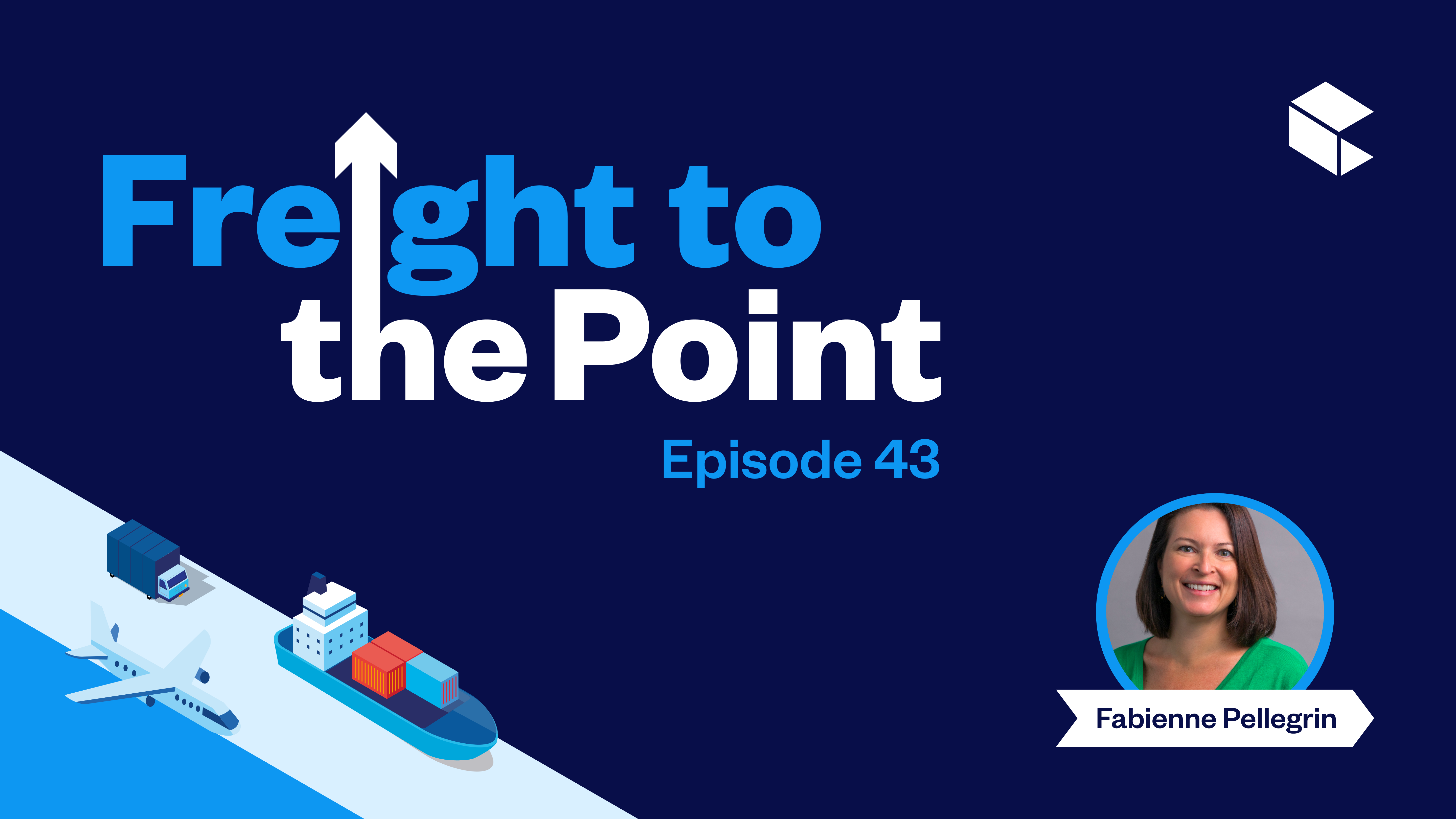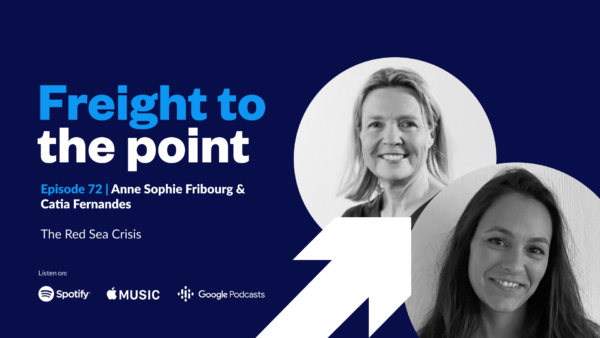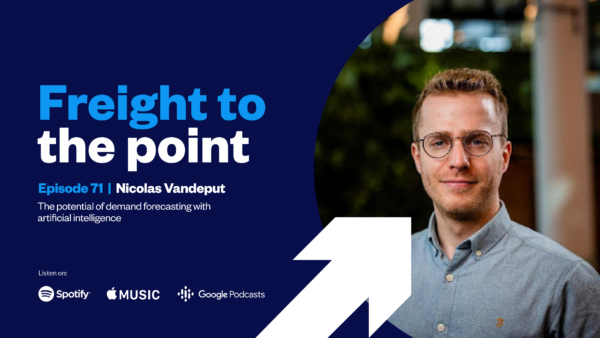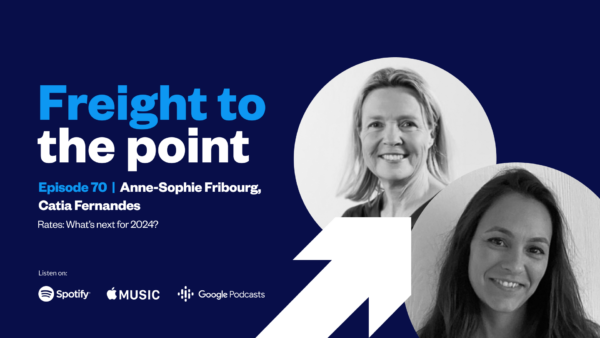Episode 43:
China’s evolution:
analysing the impact of changing conditions on consumption and production
See all episodes

What advice would you give to companies that are thinking of entering the Chinese market?
“Go big or go home.”
In our latest episode of Freight to the Point, Alex Hersham, CEO and Co-founder of Zencargo is joined by Fabienne Pellegrin, Partner at LBB Asia Limited, a brand management and consulting firm which helps brands set up or accelerate their presence in Asia.
Together, they explore:
- What has happened since China reversed its zero-Covid policy
- How this has impacted manufacturing in the country
- How the last few years have changed the way brands work in China
Fabienne Pellegrin
Fabienne Pellegrin was formerly the Head of Digital & Ecommerce Asia for Salvatore Ferragamo and the China Ecommerce Country Manager for the Tod’s Group (Tod’s, Roger Vivier & Hogan). During her tenure she spearheaded both the strategy and the execution of ecommerce & digital ecosystems for both luxury brands.
Today she is a Partner at LBB ASIA a brand management & consulting firm founded over 10 years ago which helps brands set-up or accelerate their presence in Asia. Fabienne holds an MBA from NYU Stern School of Business and grew up in Singapore in the 90s.
Resources
Lockdowns in China: questions to ask yourself to prepare for supply chain disruption
Alex Hersham:
Hi, everyone, and welcome to another episode of Freight to the Point, a podcast by Zencargo. I’m Alex Hersham, and today I’m joined by Fabienne Pellegrin, partner at LBB Asia Limited, a brand management and consulting firm founded over 10 years ago, which helps brands set up or accelerate their presence in Asia.
We’re going to be talking a lot about a very topical point around China in a post reopening environment. What does that mean? How did it all change so quickly, and what does it look like today to be operating in China? What does a consumer feel like, et cetera, et cetera. It’s a very timely podcast, so thank you so much, Fabienne, for joining, and welcome.
Fabienne Pellegrin:
Thank you, Alex. It’s lovely to be here. Thanks for inviting me over to this podcast.
Alex Hersham:
Fantastic. Let’s jump right back. In the reopening. We all saw it, saw it happen very quickly, or it seemed like it happened very quickly. What happened?
Fabienne Pellegrin:
Well, if we had this conversation in the beginning of Q4 last year, it seemed like there was no end in sight. China had a terrible, terrible 2022 with major lockdowns in many cities. Most of our team in the Shanghai office spent more than 90 days in their apartment, meaning they didn’t leave their apartment at all for over 90 days. At the beginning there was shortages of food. I mean, it was really completely crazy, and I think quite shocking for many Chinese citizens to be confronted with these types of issues.
And it seemed like it was going to be more of the same for 2023, with no reopening in sight. And then seemingly from one day to the next, they just reopened. And I think some will speculate that perhaps there was something about the protests. Everybody was bound to get sick anyway, it was better to pretend that it was on purpose rather than a failure of the measures in place. And I think the key point is probably the economy, which was taking a beating and clearly some things had to change to get out of that situation.
So for all those reasons probably and more, they announced the reopening. And from one day to the next, all of these very severe and complicated COVID measure were lifted, literally from one day to the next. And many people were very scared because they were living through, for the third year, with these measures. And to have them cancelled from one day to the next was a very stressful time. People had parents living at home or babies. And if all of these measures were necessary, surely it’s because it’s very dangerous. And so now I’m putting my family at risk. How am I supposed to manage this with no help when I’ve been guided along and babysat for the whole of COVID?
I think that was a very stressful and shocking time for everybody. And then everybody got sick. Literally every office had an 80% rate of people being sick at the same time, which as you can imagine, severely impacted operations for everyone. Then everybody had to go through those motions. I think now we’re in a better place, much more optimism for sure about the future. Relief that the worst is behind us and a relief that we can move forward. A lot of people have though lost people, family members, grandparents, parents. So it’s been a very concentrated sort of last two months, and very intense.
During that time, people were not thinking about what new handbag to buy or what new shade of lipstick to buy for the season. That was really not the concern of most consumers, and you could really feel that in the numbers. So when they announced the opening, it wasn’t just a boom of sales in the way that we’ve seen China offer in the past. It was a much slower burn type of event this time around.
Alex Hersham:
And it’s an interesting timing because going through Lunar New Year, it’s almost, it allows for a reset. And you said a lot of people caught the virus, I guess in mid to late January, we didn’t really see … We saw some manufacturing being impacted by it, but a lot of people just kept the wheels in motion. What does it feel like now, what’s sort of the mood coming into the new year?
Fabienne Pellegrin:
Well, you’re right, I think we were able to bury the tiger and pull all of our hope and optimism on the new Year of the Rabbit, and that’s probably not an accident, I think, so as I said, I think there’s a lot of relief about entering a new era. One thing to keep in mind, however, is that China has changed in a big way. And the China that we left three years ago is very different from the one that we see coming on the other end of this.
And for several reasons. I think one of them is that, well, China’s been living literally in a bubble for three years. And this has given an opportunity to many of the domestic brands, Chinese brands, to really prosper and bloom into the Chinese consumer market. So now you have incredible Chinese brands on all categories that you wouldn’t have imagined seeing five years ago. And these brands are catered specifically to the Chinese consumer habits, and to their life, and to their specific needs.
And so it’s become, in some categories, extremely difficult for foreign brands to compete because they have a product that fits globally, that probably works in most other countries, but in China it’s just not a … It doesn’t have that competitive edge. Because the Chinese contender is specifically catered to the Chinese consumer. And all of that China pride now is completely justified because it’s amazing brands, incredible customer experience, branding, retail concept, customer service, the works. It’s truly become a highly, highly competitive space for foreign brands.
So unless you’re a Louis Vuitton, a Chanel, and you have that kind of level, if you’re competing in the middle bit, it’s a much tougher game. And some people, honestly, will probably fail.
Alex Hersham:
Yeah. Let’s talk first about the luxe and then come down to that mid-market. So do you think the luxe market is insulated, the traditional European brands, really strong brands like you mentioned, are they insulated? Or is it also the pace of change, the pace of innovation, does that also pose a risk to those brands in China?
Fabienne Pellegrin:
Well, first of all, those brands are sufficiently big and have sufficiently enough budget to understand that China is a key market for them. And so they are already ingrained and they already have products that are kind of China products. In addition to that, they’ve become an investment vehicle in a much bigger way than ever. So they feel like a safe spend for many of the top Chinese consumers.
So they’re relatively unchallenged in that arena. I mean, there’s a couple of grassroot luxury brands that are coming out and we’ll probably see more, but they’re not going to have 150, 200 years heritage in the way that these brands have. That’s the one thing that’s difficult to mimic. And so they are, I would say, the safest out of all of the foreign brands that are trying to compete in China for now.
Alex Hersham:
And then the mid-market, you’re saying the concepts that have come out of China are just so well catered, so energized. In your role, in terms of supporting brands to set up or supporting brands to accelerate, what advice are you giving to those types of companies who are either in the market or thinking of entering the market but facing really strong competition?
Fabienne Pellegrin:
Well, I think go big or go home, in a way. And what we mean by that is, if you’re not ready to really cater to the Chinese market at the product level, that means having a China fit, looking at what the China use case scenarios are for your specific products, and are ready to put the investment beyond just having a social media account in China with Chinese models, that’s not going to cut it. You really need to have a holistic China strategy to make it in China. And if you are not able to do that, then maybe that investment is better spent in different markets than in China.
I think one thing to look at in China is in the past, when there’s been rebounds after a difficult or an economic crisis, it’s been mostly big government investments and the type of economic recovery that had large spill overs globally. And so China was able to prop up a little bit the global economy with all of the government injections, et cetera. This time around however, a lot of the infrastructure’s already built. And it’s really going to be a recovery that’s more based on consumption. And that means products, that means services, that means travel. And so there’s an opportunity maybe on the travel side, but on the consumption side, it’s a much tougher market, as I said, than in the past.
But that being said, the urbanization rates in China is 62%. Now you’re in London, in the UK it’s 84%. So there’s still a lot of potential for that market to grow, and it will grow. And I think the prediction is that we’ll have 70 million more Chinese middle class consumers in the next three years. And so we are talking about annual income, about 22,000 euros, 160,000 renminbi.
So there’s still potential for the market to grow, for the pie to get bigger. But we also have a market that’s really operating at a parallel. You may know that already the digital ecosystem in China is completely segregated from the rest of the world. You don’t have Google, you don’t have Facebook. They have their own Chinese champions that operate in a very specific and different way. The government also has a lot of regulatory measures in place to protect that market. Consumer data, for example, has to be stored in China, servers in China, which is a problem for global brands when they want to have eCommerce from China and it’s send all that data back to HQ. That’s not possible in China.
So it has all these specific requirements, which means that you have to have a clear understanding in this fast-paced, complicated environment. And budget to cater specifically to it, which is not the case of any brand.
Alex Hersham:
Yeah, very difficult. It almost makes you wonder, to use your saying go big or go home, it makes you wonder, obviously the large luxe brand with their presence, with their history and with their budgets can sort of do this. For medium-sized brands up-and-comers, you said …
What do you do? What are you advising customers to do? I know the go big or go home, but that is quite binary. Is there a way of brands working together or is there a way of doing concessions? How can brands leverage? Because having 70 million new middle class is huge in the context of a Western market, so how can brands still navigate this?
Fabienne Pellegrin:
Well, every case has to be individually looked at. Basically, if you have something very differentiating, that you have something in your product that’s truly innovative and that’s not yet present in China, then you have a chance to succeed. Although that chance, there’s a window of opportunity there, where you need to go in quick before the copycats of the market grab that market share in your place. So I think it’s important before going into China to really understand your space, understand who your competitors would be, what is it that you are offering that you’re not, and what’s your legitimacy in that area for a Chinese consumer?
I would say the other thing is to really … China is a very, very big market, but it’s also, you are not talking to China, you’re talking to a specific target. And for you to understand who is that target, where they live, what they care about, which KOLs do they follow, what cities they live in, is really an important exercise. So the market research box, which some brands have a tendency to skip because they know what works in other countries and they kind of just roll with it because they feel that they understand it, in China really that’s an expensive one to try to bypass. You really need to understand where you’re going, how much it’s going to cost, what you’re up against, to have the winning strategy.
Alex Hersham:
And is that something that you support clients on in terms of doing that market research and helping them with the consultation period before even deciding go-to-market strategy?
Fabienne Pellegrin:
Yeah, that’s exactly actually why we created LBB was to really help brands to understand how the market operates with people that are on the ground. We try to help brands do exactly what I’ve just described. So if you have a certain product in a certain category to understand, what does that space look like? How much would it cost to enter it, how long would it take to get to breakeven? What kind of investment do you need to put in? What kind of business models are available to you, a JV, a distributor or going direct, and how that impacts your P&L in the long-run. And then we can help you run the operations locally for you until you’re big enough to run your own team.
So that’s kind of our business model. Typically, we’ll do a phase one where you sort of map out the market specifically for your brand. And the phase two is we will run the operations for you for one to three years, and then once you’ve reached critical size, then you take over the business because you’ll be big enough for it to be cost-effective.
Alex Hersham:
Well, that’s a great rally proposition, both the research, but then also the early finding product market fit, to use a tech term. That’s very, very cool.
Last question for me in terms of the new post COVID China. We talked about brands tailored to the local market and making it more difficult, et cetera, et cetera. You spoke a little bit though about travel. What are some of the other consumer trends that you’re seeing are different to pre COVID China?
Fabienne Pellegrin:
Well, certainly I think there was a big retail entertainment component in the way that the Chinese were consuming. There was a feeling that tomorrow was going to be better than before, that the … A lot of the savings in China are linked to the real estate markets. And so everything was on the up and up and they were sure that the future was bright. And so there was a lot of frivolous spending, the crazy 11/11 deals, or just buying for fun and because they can.
And now that’s very different. I think they’re much more concerned about the future. There’s much more saving. The real estate markets is in a slump, and people are much more careful about how they buy. They want value, they want quality and they will buy less, but better. And so they’re much more discerning in their purchases. So that’s also harder for brands where before, you could dazzle them with a cool campaign and probably people were going to try it out. Now it takes a little bit more to convince a consumer to try out your brand for the first time.
I would say that the Chinese consumer is a little bit more cautious than we’ve known him to be in the past. And that’s a big change for brands.
Alex Hersham:
Well, it feels like a very interesting and dynamic environment in the post COVID China. I think the year ahead is going to be a very interesting one. I totally see your points around understanding go-to-market strategy, making sure that you’re tailoring. And just this whole change that’s happened over the past few years.
It’s great that you’ve been on the podcast today. Hopefully our listeners have been able to hear and navigate and make sure that they don’t just try to rinse and repeat what worked in 2018, 2019, and think it’s going to work going forward. Before we wrap up, is there anything else that you would like to share?
Fabienne Pellegrin:
I think China can be a bit of a scary place, because it’s big and it’s quite different from everywhere else, but it’s also a very exciting place for exactly those reasons. There’s a lot of opportunities there. And this Year of the Rabbit we are feeling a lot of optimism after three very dark years. Well, actually I shouldn’t say that. Last year was dark. Throughout COVID it was actually pretty great, just separate from everybody else.
But I think China has a lot to offer coming up. And first of all, now that people can travel, come on over and come and see it for yourself. And I think there’s lots of great things that have come out of the market and a lot of great opportunities to seize for sure.
Alex Hersham:
Fantastic. Well, thank you so much for joining us, and thank you to everyone listening for joining for another episode of Freight to the Point. Don’t forget to like, subscribe or follow our series on Spotify, Apple or Google Podcasts, if you enjoyed this episode. And if you have any questions, as always, please feel free to reach out to me directly. Until next time, Fabienne, thank you very much and thank you to all of our listeners. Have a good day.

Episode 72: The Red Sea Crisis
In the latest episode of Freight to the Point, we’ve featured our most rec...

Episode 71: The potential of demand forecasting with artificial intelligence
In the most recent instalment of Freight to the Point, Lucie Phillips, Zen...

Episode 70: Rates: What's next for 2024?
As we prepare for the year ahead, it's crucial to consider the three pillars...

